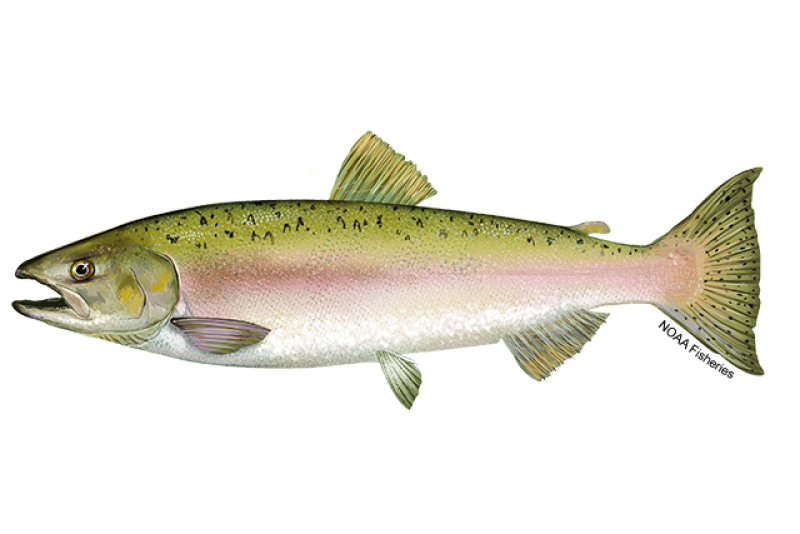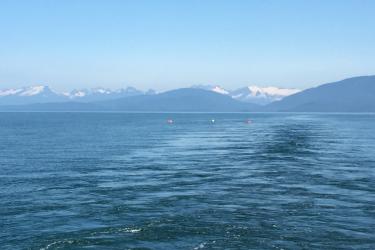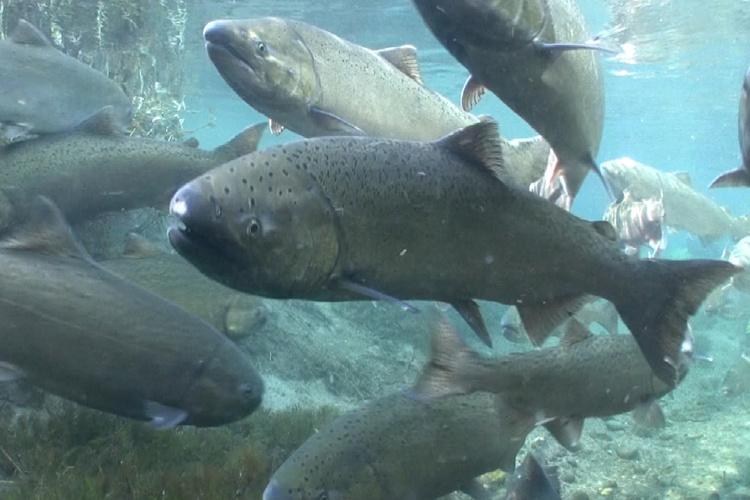 Spring Chinook Salmon. Credit: Michael Humling, U.S. Fish & Wildlife Service
Spring Chinook Salmon. Credit: Michael Humling, U.S. Fish & Wildlife Service
Spring Chinook Salmon. Credit: Michael Humling, U.S. Fish & Wildlife Service
About the Species
 Spring Chinook Salmon. Credit: Michael Humling, U.S. Fish & Wildlife Service
Spring Chinook Salmon. Credit: Michael Humling, U.S. Fish & Wildlife Service
Spring Chinook Salmon. Credit: Michael Humling, U.S. Fish & Wildlife Service
U.S. wild-caught Chinook salmon is a smart seafood choice because it is sustainably managed and responsibly harvested under U.S. regulations.
NOAA Fisheries works in cooperation with federal, state, tribal, and Canadian officials to manage these commercial, recreational, and tribal harvest of salmon and steelhead in ocean and inland waters of the West Coast and Alaska. To learn more about management of these fisheries, visit our West Coast and Alaska fisheries management pages.
However, some Chinook salmon are also protected under the Endangered Species Act. Learn more about protected Chinook salmon.
Appearance
- When they’re in the ocean, Chinook salmon are blue-green on the back and top of the head with silvery sides and white bellies.
- They have black spots on the upper half of the body and on both lobes of the tail fin.
- Chinook salmon also have a black pigment along the gum line, thus the nickname "blackmouth."
- In fresh water, when they are about to spawn, Chinook change to olive brown, red, or purplish. This color change is particularly evident in males.
- Spawning adult males can be distinguished by their hooked upper jaw.
- Females can be distinguished by a torpedo-shaped body, robust mid-section, and blunt nose.
- Juveniles in fresh water (fry) have well-developed parr marks on their sides (the pattern of vertical bars and spots useful for camouflage).
- Before juveniles migrate to the sea, they lose their parr marks and gain the dark back and light belly characteristic of fish living in open water.
Biology
- Chinook salmon are anadromous—they hatch in freshwater streams and rivers then migrate out to the saltwater environment of the ocean to feed and grow.
- Chinook salmon are the largest of the Pacific salmon, hence the name “king salmon.”
- They can grow as long as 4.9 feet and up to 129 pounds, but typical length and weight of mature fish are about 3 feet and 30 pounds.
- They spend a few years feeding in the ocean, then return to their natal streams or rivers to spawn, generally in summer or early fall.
- Chinook salmon sexually mature between the ages of 2 and 7 but are typically 3 or 4 years old when they return to spawn.
- Chinook dig out gravel nests (redds) on stream bottoms where they lay their eggs.
- All Chinook salmon die after spawning.
- Young Chinook salmon feed on terrestrial and aquatic insects, amphipods, and other crustaceans.
- Older Chinook primarily feed on other fish.
- Fish (such as whiting and mackerel) and birds eat juvenile Chinook salmon.
- Marine mammals, such as orcas and sea lions, and sharks eat adult salmon.
- Salmon are also primary prey for Southern Resident killer whales, an endangered species.
- After salmon spawn and die, salmon carcasses are a valuable source of energy and nutrients to the river ecosystem. Carcasses have been shown to improve newly hatched salmon growth and survival by contributing nitrogen and phosphorous compounds to streams.
Where They Live
Range
- In North America, Chinook salmon range from the Monterey Bay area of California to the Chukchi Sea area of Alaska.
Habitat
- Chinook salmon spend their early life growing and feeding in freshwater streams, estuaries, and associated wetlands.
- They spend the remainder of their life foraging in the ocean before returning to the streams and tributaries where they were born to spawn.
Scientific Classification
- In North America, Chinook salmon range from the Monterey Bay area of California to the Chukchi Sea area of Alaska.
- Chinook salmon spend their early life growing and feeding in freshwater streams, estuaries, and associated wetlands.
- They spend the remainder of their life foraging in the ocean before returning to the streams and tributaries where they were born to spawn.
Scientific Classification
| Kingdom | Animalia | Phylum | Chordata | Class | Actinopterygii | Order | Salmoniformes | Family | Salmonidae | Genus | Oncorhynchus | Species | tshawytscha |
|---|
Last updated by NOAA Fisheries on 04/04/2025
Featured News
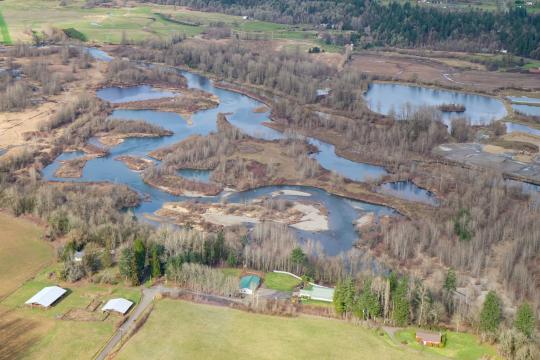 Aerial view of the Ridgefield Pits in the foreground on the East Fork Lewis River before restoration. The Daybreak Pits can also be seen and are located adjacent to the Ridgefield Pits. The project will focus on restoring the nine Ridgefield Pits. Credit: Lower Columbia Estuary Partnership
Aerial view of the Ridgefield Pits in the foreground on the East Fork Lewis River before restoration. The Daybreak Pits can also be seen and are located adjacent to the Ridgefield Pits. The project will focus on restoring the nine Ridgefield Pits. Credit: Lower Columbia Estuary Partnership
Washington State River Restoration Project to Revive Salmon Habitat, Support Local Jobs
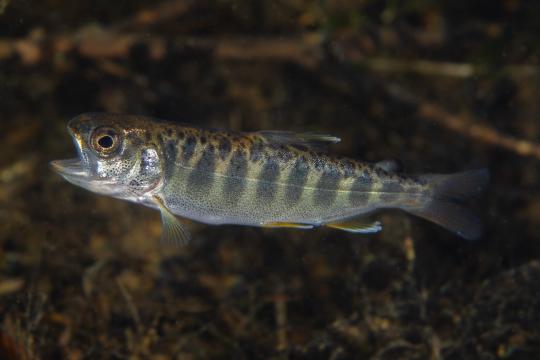 Chinook salmon. (Credit: NOAA Fisheries)
Chinook salmon. (Credit: NOAA Fisheries)
Microsoft Provides AI and Cloud Computing for NOAA Project to Better Map Prime Salmon Habitat
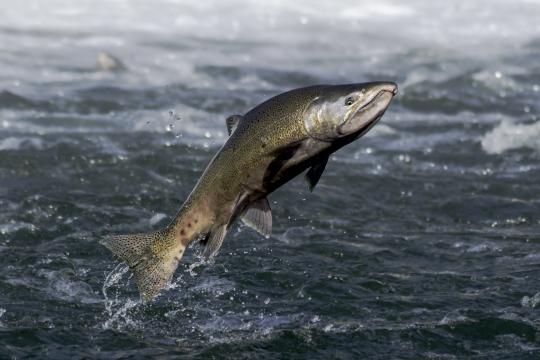 A Chinook salmon jumping out of the water. Credit: iStock
A Chinook salmon jumping out of the water. Credit: iStock
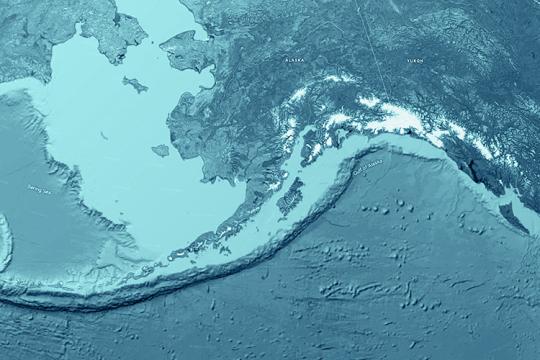 3D render and imaging of topographic map of Alaska showing the Gulf of Alaska, Aleutian Islands and Bering Sea. Satellite images courtesy of NASA. Credit: Frank Ramspott
3D render and imaging of topographic map of Alaska showing the Gulf of Alaska, Aleutian Islands and Bering Sea. Satellite images courtesy of NASA. Credit: Frank Ramspott
Seafood Facts

Is Chinook Salmon Sustainable?
Although some Chinook populations are below target levels, U.S. wild-caught Chinook salmon is a smart seafood choice because they are sustainably managed with careful consideration given to impacts on endangered and threatened species.
Availability
Fresh mainly in the summer and early fall, though the timing varies by area and fishery. Frozen year-round.
Source
U.S. wild-caught from Alaska to California.
Taste
Chinook salmon has a pronounced buttery, rich taste. They are the most highly prized salmon in the culinary world. White Chinook taste the same as the darker variety.
Texture
Oily, flaky, and meaty.
Color
The meat is almost always red, never pink, except for the rare white-meat variety.
Health Benefits
Chinook salmon is low in sodium and is a good source of omega-3 fatty acids, protein, niacin, vitamin B12, and selenium.
Nutrition Facts
Servings: 1; Serving Weight: 100 g (raw); Calories: 179; Protein: 19.93 g; Total Fat: 10.43 g; Total Saturated Fatty Acids: 3.1 g; Carbohydrate: 0 g; Total Sugars: 0 g; Total Dietary Fiber: 0 g; Cholesterol: 50 mg; Selenium: 36.5 mcg; Sodium: 47 mgMore Information
Chinook Salmon Recipes
Chinook salmon is a prized sushi and sashimi meat. It has a bold, buttery flavor and is rich in omega 3. For cooking inspiration, browse these recipes for sushi cups, grilled salmon, and more!

Last updated by NOAA Fisheries on 04/04/2025
Seafood News
 Fresh-caught taʻape on ice. Credit: Conservation International Hawaiʻi.
Fresh-caught taʻape on ice. Credit: Conservation International Hawaiʻi.
Reducing Waste and Feeding Communities in Hawaiʻi with a Whole Fish Approach
 Chef Tyler Hadfield’s Curried Skate Wings with Tomato-Masala Chutney
Chef Tyler Hadfield’s Curried Skate Wings with Tomato-Masala Chutney
Ring In the New Year With These Crowd-Favorite Seafood Recipes
 NOAA Fisheries, in collaboration with Blue Ocean Mariculture, is conducting a multi-year pilot study to evaluate observational methods and tools for studying Hawaiian monk seal behavior. Courtesy of Blue Ocean Mariculture
NOAA Fisheries, in collaboration with Blue Ocean Mariculture, is conducting a multi-year pilot study to evaluate observational methods and tools for studying Hawaiian monk seal behavior. Courtesy of Blue Ocean Mariculture
AI Meets Aquaculture to Study Hawaiian Monk Seal Interactions With Net Pens
 Tonya Wick aboard a fishing vessel at sea in 1998. Photo courtesy of Tonya Wick
Tonya Wick aboard a fishing vessel at sea in 1998. Photo courtesy of Tonya Wick
Last updated by NOAA Fisheries on 04/04/2025
Population Status
There are numerous stocks of Chinook salmon.
- Alaska:
- In Alaska, the status of Chinook salmon stocks varies.
- Some stocks are in decline, while others are steady or increasing.
- None are listed under the Endangered Species Act (ESA).
- According to the 2022 stock assessment, the Eastern North Pacific Far North Migrating stock is not overfished and not subject to overfishing. Summary stock assessment information can be found on Stock SMART.
- West Coast:
- The status of Chinook stocks in California and the Pacific Northwest varies.
- Some stocks are in decline, while others are steady or increasing.
- As of 2025, two populations of Chinook salmon are listed as endangered, and seven are listed as threatened under the ESA.
- According to the 2024 stock assessment, the Klamath River Fall stock is overfished, but not subject to overfishing. According to the 2023 stock assessment, the Queets Spring/Summer stock is overfished, but the overfishing status is unknown. The remaining stocks are not overfished and not subject to overfishing. Summary 2024 stock assessment information for all West Coast Chinook salmon stocks can be found on Stock SMART.
- Populations are affected by:
- Changes in ocean and climatic conditions.
- Habitat loss from dam construction and urban development.
- Degraded water quality from agricultural and logging practices.
- Population conservation efforts include:
- Captive-rearing in hatcheries.
- Removal and modification of dams that obstruct salmon migration.
- Restoration of degraded habitat.
- Acquisition of key habitat.
- Improvements to water quality and instream flow.
- The Pacific Coastal Salmon Recovery Fund supports the restoration of salmon species.
Fishery Management
- NOAA Fisheries and the Pacific Fishery Management Council manage Chinook salmon on the West Coast.
- Managed under the Pacific Coast Salmon Plan:
- Every year, the council reviews reports of the previous fishing season and current estimates of salmon abundance. Using this information, they make recommendations for management of the upcoming fishing season.
- Their general goal is to allow fishermen to harvest the maximum amount of salmon that will support the fishery while preventing overharvest of the resource and ensuring that salmon populations with low abundance can rebuild.
- Specific management measures vary year to year depending on current salmon abundance, and include size limits, season length, quotas, and gear restrictions.
- Management of Chinook salmon must also comply with laws such as the Endangered Species Act. One of the threats to recovery of endangered Southern Resident killer whales on the West Coast is the availability of their preferred prey, Chinook salmon. Every year the fishery management council considers the prey needs of this endangered population before setting commercial fishing catch limits for Chinook. Read more
- Final recommendations are implemented by NOAA Fisheries. Check here for the current season’s management. State and tribal managers use council management recommendations to shape their policies for inland fisheries, to ensure that conservation objectives are met.
- A rebuilding plan to rebuild the Klamath River Fall Chinook stock to the target population level is in place with a target date of 2021.
- NOAA Fisheries and the North Pacific Fishery Management Council manage Chinook salmon in Alaska.
- Managed under the Fishery Management Plan for Salmon Fisheries in the EEZ off the Coast of Alaska:
- All management of the salmon fisheries in federal waters is delegated to the State of Alaska, which is also responsible for managing the commercial, recreational, and subsistence fisheries for salmon in state waters. This ensures that management is consistent throughout salmon’s range.
- Managers regulate the fishery based on escapement goals to ensure harvests are sustainable. They want enough salmon to be able to escape the fishery and return to fresh water to spawn and replenish the population.
- Salmon fishery management largely relies on in-season assessment of how many salmon return to fresh water to spawn.
- Managers set harvest levels based on these returns. When abundance is high and the number of fish returning is much higher than that needed to meet escapement goals, harvest levels are set higher.
- In years of low abundance, harvest levels are lowered.
- During the fishing season, scientists monitor catch and escapement, comparing current returns with those from previous years, to keep an eye on abundance and actively manage the fishery.
- All management of the salmon fisheries in federal waters is delegated to the State of Alaska, which is also responsible for managing the commercial, recreational, and subsistence fisheries for salmon in state waters. This ensures that management is consistent throughout salmon’s range.
- Off the West Coast and in Alaska, the Pacific Salmon Treaty and the Pacific Salmon Commission help coordinate management, research, and enhancement of shared U.S. and international salmon stocks, including Chinook.
Harvest
- Commercial fishery:
- In 2023, U.S. commercial landings of Chinook salmon totaled 7.6 million pounds and were valued at $31 million, according to the NOAA Fisheries commercial fishing landings database.
- Most of the Chinook in the U.S. market comes from U.S. and Canadian fisheries.
- Gear types, habitat impacts, and bycatch:
- Chinook salmon are harvested using a variety of gear types.
- Troll vessels catch salmon by "trolling" their lines with bait or lures through groups of feeding fish.
- To retrieve hooked fish, the lines are wound on spools by hand or hydraulically, and the fish are pulled aboard when alongside the vessel.
- The troll fishery produces low-volume, high-quality product.
- Chinook are also harvested in commercial seine and gillnet fisheries (described here), both in fisheries targeting stocks of Chinook and as bycatch in fisheries targeting other species of salmon.
- Fishing gear used to catch Chinook salmon rarely contacts the ocean floor and has little impact on habitat.
- Bycatch is low and usually consists of other salmon species.
- Recreational fishery:
- Chinook salmon are a favorite catch of recreational fishermen.
- Recreational fishermen use a variety of fishing gear to harvest Chinook salmon.
- To ensure recreational fisheries are sustainable, West Coast anglers are only allowed to keep a certain number of salmon per fishing trip.
- In Alaska, regulations vary by area and individual fisheries.
- Recreational fisheries in high-use areas (Cook Inlet, Southeast Alaska, Copper River) are regulated through management plans that allocate fish between competing commercial and recreational fishermen.
- Subsistence fishery:
- Salmon is an important source of spiritual and physical sustenance for Western Indian tribes and Alaska natives, and salmon are culturally important to many other residents of these areas.
- Subsistence fishermen use a variety of fishing gear to harvest Chinook salmon.
Last updated by NOAA Fisheries on 04/04/2025
Science Overview

NOAA Fisheries conducts various research activities on the biology, behavior, and ecology of chinook salmon. The results of this research are used to inform management decisions for this species.
For detailed information about stock status, management, assessments, and resource trends, you can search for chinook salmon, and any other species of interest, using NOAA’s StockSMART web tool
Chinook Salmon Research in Alaska
Our work to forecast salmon harvests, assess the impact of commercial fisheries on salmon, and evaluate how salmon populations respond to environmental changes enables us to estimate abundance and trends for chinook salmon in Alaska.
More on salmon research in Alaska
Chinook Salmon Research in the Pacific Northwest
Our research on Pacific salmon covers several topics including bycatch, salmon harvest forecasts, ecotoxicology, genetics, marine survival and responses to climate change.
More on Chinook salmon research in the Pacific Northwest
Last updated by NOAA Fisheries on 04/04/2025
Documents
2024 5-Year Review: Summary & Evaluation of California Coastal Chinook Salmon
Five-year reviews describe whether recovery is on track in the context of the recovery plan,…
Endangered Species Act Section 7(a)(2) Biological Opinion and Magnuson–Stevens Fishery Conservation and Management Act Essential Fish Habitat Response for the Stibnite Gold Project
NMFS Consultation Number: WCRO-2023-02924
Cook Inlet Small Entity Compliance Guide
The Small Entity Compliance Guide (select "View Document" below) contains a summary of regulations…
2024 5-Year Review: Summary & Evaluation of Upper Willamette River Steelhead Upper Willamette River Chinook Salmon
Five-year reviews describe whether recovery is on track in the context of the recovery plan,…
Data & Maps
2008: Genetic Stock Composition Analysis Of Chinook Salmon Bycatch Samples From The 2008 Bering Sea Pollock Trawl Fisheries
Alaska Fisheries Science Center Salmon Bycatch Report
Research
GoToWebinar Registration and Joining Instructions
How to register and join meetings for the Alaska Salmon Research Task Force
Frequent Questions—Snow Crab and Salmon Declines in Alaska
NOAA Fisheries answers questions about what is behind the declines in snow crab and salmon and how we are addressing them.
Outreach & Education
Little Port Walter Program Flyer
This program is in NOAA Fisheries Alaska's Auke Bay Laboratories.
Alaska Salmon Research Task Force Meeting Agenda—May 22, 2024
Alaska Salmon Research Task Force Meeting Agenda for May 22, 2024
Alaska Salmon Research Task Force Meeting Agenda—January 25, 2024
Alaska Salmon Research Task Force Meeting Agenda for January 25, 2024
Central Valley Spring-run Chinook Salmon Brochure
Spring-run Chinook salmon were once abundant throughout rivers and creeks in California’s Central…
Last updated by NOAA Fisheries on 04/04/2025




